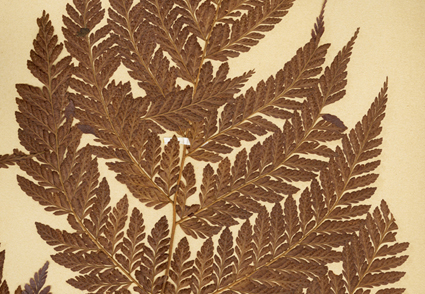Abstract
When reviewing the species diversity of Dryopteridaceae from Vietnam, we noticed the name Dryopteris microlepioides Christensen (1934: 102) is taxonomically uncertain and to be treated (Hassler 1994–2024). Dryopteris microlepioides was described based on two collections from northern Vietnam and was thought to be a distinct species superficially resembling Microlepia speluncae (Linnaeus 1753: 1093) Moore (1857: 93) (Christensen 1934). Since its publication in 1934, this name had been neglected by authors who treated Dryopteris Adanson (1763: 20) for the fern flora or species diversity of Vietnam (e.g., Tardieu-Blot & Christensen 1938, 1941; Pham 1999; Phan 2010). At the first sight of the type specimens of D. microlepioides, the senior author (SYD) was aware of D. microlepioides representing the same taxon with Trichoneuron microlepioides Ching (1965: 119) described from southern Yunnan, China, because this taxon is morphologically unique by having the microlepioid frond habit (especially with copious pale hairs on both surfaces) and the dryopterioid sori (reniform, medial on abaxial surface of lamina) (Fig. 1). Phylogenetically, the sample of this species from northern Vietnam, which was identified as T. microlepioides by Liu et al. (2016), was resolved to be sister to Polystichopsis (Smith 1875: 217) Holttum (1947: 147) in Dryopteridaceae subfam. Polybotryoideae based on the analysis of three cpDNA sequences (rbcL, atpA, and atpB) (Liu et al. 2016). In recent years, we also collected this taxon in northern Vietnam (paratype locality of D. microlepioides) and southern Yunnan, China, and conducted phylogenetic analysis based on cpDNA genome (not presenting here). Our analysis resolved one sample from Vietnam (Dong 4598) and two collections from Yunnan (Dong 4801 and Zuo 5093) clustered together, identifying no any significant difference between them. The three samples in the phylogenetic tree formed a sister relationship in high supporting values with Polystichopsis as the result in Liu et al. (2016). This result provides further evidence supporting the same species of D. microlepioides Christensen (1934) with T. microlepioides Ching (1965).
References
- Adanson, M. (1763) Familles des Plantes, vol. 2. Vincent, Paris, 640 pp. [https://www.biodiversitylibrary.org/item/6958]
- Ching, R.C. (1965) Two new fern genera from China. Acta Phytotaxonomica Sinica 10 (2): 115–120. [https://www.jse.ac.cn/EN/Y1965/V10/I2/115]
- Christensen, C. (1934) Filices novae Indochinenses. Bulletin d’information, Muséum National d’Histoire Naturelle (Paris) 26 (6): 100–106.
- Christensen, C. (1938) Filicinae. In: Verdoorn, F. (Ed.) Manual of Pteridology. Martinus Nijhoff, The Hague, pp. 522–550. https://doi.org/10.1007/978-94-017-6111-6_20
- Chu, W.M. & He, Z.R. (2000) Taxonomic notes on some pteridophytes from Yunnan (II). Acta Botanica Yunnanica 22: 255–262.
- Hassler, M. (1994–2024) World Plants, Synonymic Checklist and Distribution of ferns and lycophytes of the World, version 19.3. [https://worldplants.de/ferns]
- Holttum, R.E. (1947) A revised classification of Leptosporangiate ferns. Botanical Journal of the Linnean Society 53: 123–158. https://doi.org/10.1111/j.1095-8339.1947.tb02554.x
- Linnaeus, C. (1753) Species Plantarum, vol. 2. Impensis Laurentii Salvii, Holmiae, 640 pp. [http://www.biodiversitylibrary.org/item/13830]
- Liu, H.M., Zhang, X.C., Wang, M.P., Shang, H., Zhou, S.L., Yan, Y.H., Wei, X.P., Xu, W.B. & Schneider, H. (2016) Phylogenetic placement of the enigmatic fern genus Trichoneuron informs on the infra-familial relationship of Dryopteridaceae. Plant Systematics and Evolution 302: 319–332. http://doi.org/10.1007/s00606-015-1265-3
- Moore, T. (1857) Index Filicum. William Pamplin, London, 558 pp. [https://www.biodiversitylibrary.org/item/115962]
- Pham, H.H. (1999) An Illustrated Flora of Vietnam, vol. 1. Youth Publishing House, Hanoi, 618 pp.
- Phan, K.L. (2010) The updated checklist of the fern flora of Vietnam following the classification scheme of A. Smith et al. (2006). Journal of Fairylake Botanical Garden 9: 1–13.
- Smith, J. (1875) Historia Filicum. Machillan & Co., London, 429 pp. [https://www.biodiversitylibrary.org/item/1822]
- Tardieu-Blot, M.L. & Christensen, C. (1938) Les fougéres d’Indochine 15, Dryopteridaceae. Notulae Systematicae (Paris) 7: 65–104. [https://www.biodiversitylibrary.org/item/7374]
- Tardieu-Blot, M.L. & Christensen, C. (1941) Dryopteridaceae. Flore Générale de l’Indo-Chine 7 (8): 297–440.


